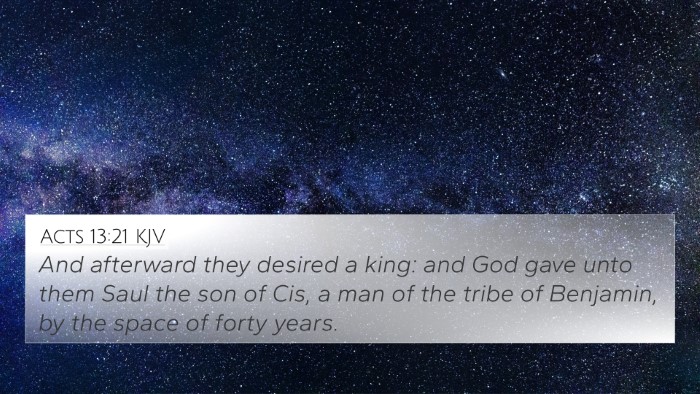Understanding 1 Samuel 9:15
The verse 1 Samuel 9:15 reads: "Now the Lord had told Samuel in his ear a day before Saul came, saying..." This verse marks a significant point in the narrative of the rise of Saul as king of Israel. The insights provided by noted public domain commentators bring depth to this passage, illustrating its theological and historical importance.
Summary of 1 Samuel 9:15
In this verse, we see a pivotal moment where God prepares Samuel for the arrival of Saul. The intimate communication between God and Samuel showcases the divine guidance that Samuel receives as a prophet. It signifies God's sovereignty and foreknowledge, assuring us that He operates beyond human understanding and time.
Insights from Commentators
-
Matthew Henry:
Henry emphasizes the divine communication aspect of this verse, noting how God speaks to Samuel "in his ear." It highlights the personal relationship between God and His prophet, suggesting that God prepares His servants ahead of time for significant events.
-
Albert Barnes:
Barnes underscores the implications of God's prior warning to Samuel. The verse illustrates that God has a plan for Israel's governance, which involves human agency, represented by Saul’s emergence as a leader. These preparatory events signal God's providence in the affairs of His people.
-
Adam Clarke:
Clarke adds to the interpretation by discussing the significance of Saul's arrival. He postulates that God gives Samuel specific revelation to enhance the faith of His prophet amid Israel's growing desire for a king, foreshadowing both the blessings and challenges that Saul would bring.
Bible Verse Cross-References
This verse connects with several other Bible passages that highlight God’s communication with His prophets and the themes of leadership and providence. Below are key cross-references:
- 1 Samuel 3:10 - God calls Samuel, indicating His choice for prophetic leadership.
- 1 Samuel 8:7 - God tells Samuel to heed the people's request for a king, revealing God's overarching plans.
- 1 Kings 19:12 - God speaks to Elijah in a still small voice, exemplifying personal communication.
- Jeremiah 1:5 - God's knowledge of Jeremiah before his birth mirrors the sovereign election seen in Saul's call.
- Isaiah 6:8 - The calling of a prophet resonates with Samuel's experience in 1 Samuel 9:15.
- John 15:16 - Jesus speaks about divine selection and purpose for His followers, paralleling God's choice of Saul.
- Acts 13:22 - Paul refers to God choosing David, drawing a line of leadership from Saul to David, confirming God's plan and foresight.
Connections Between Bible Verses
This verse serves as a launching point for a broader discussion about divine communication and leadership in the Bible. Here are some thematic connections:
- Thematic Bible Verse Connections: The theme of God's guidance continues throughout the lives of many individuals in Scripture, illustrating a model of divine-human interaction.
- Scriptural Cross-Referencing: The episode of Saul's anointing can be linked with narratives of God's selection and anointing of leaders, reinforcing His authority in governance.
- Inter-Biblical Dialogue: The dialogues between God and His prophets in both the Old and New Testaments reveal consistent patterns of divine revelation and purpose.
Comparative Bible Verse Analysis
When conducting comparative analyses, consider how God prepared His prophets in various contexts:
- Examine the calling of Gideon (Judges 6:11-16) alongside Samuel to understand differing reactions to God’s call.
- Contrast Samuel's role in Israel's transition to monarchy with Moses' leadership during the Exodus, focusing on God's preparation of leaders.
Conclusion
1 Samuel 9:15 exemplifies the intimate and directive relationship between God and His chosen leaders in Israel's history. Through commentaries and cross-references, we see the rich tapestry of biblical themes—divine communication, providence, and the establishment of leadership. Each verse connected to this passage enhances our understanding of God's plan, urging us towards deeper theological insights and applications.













